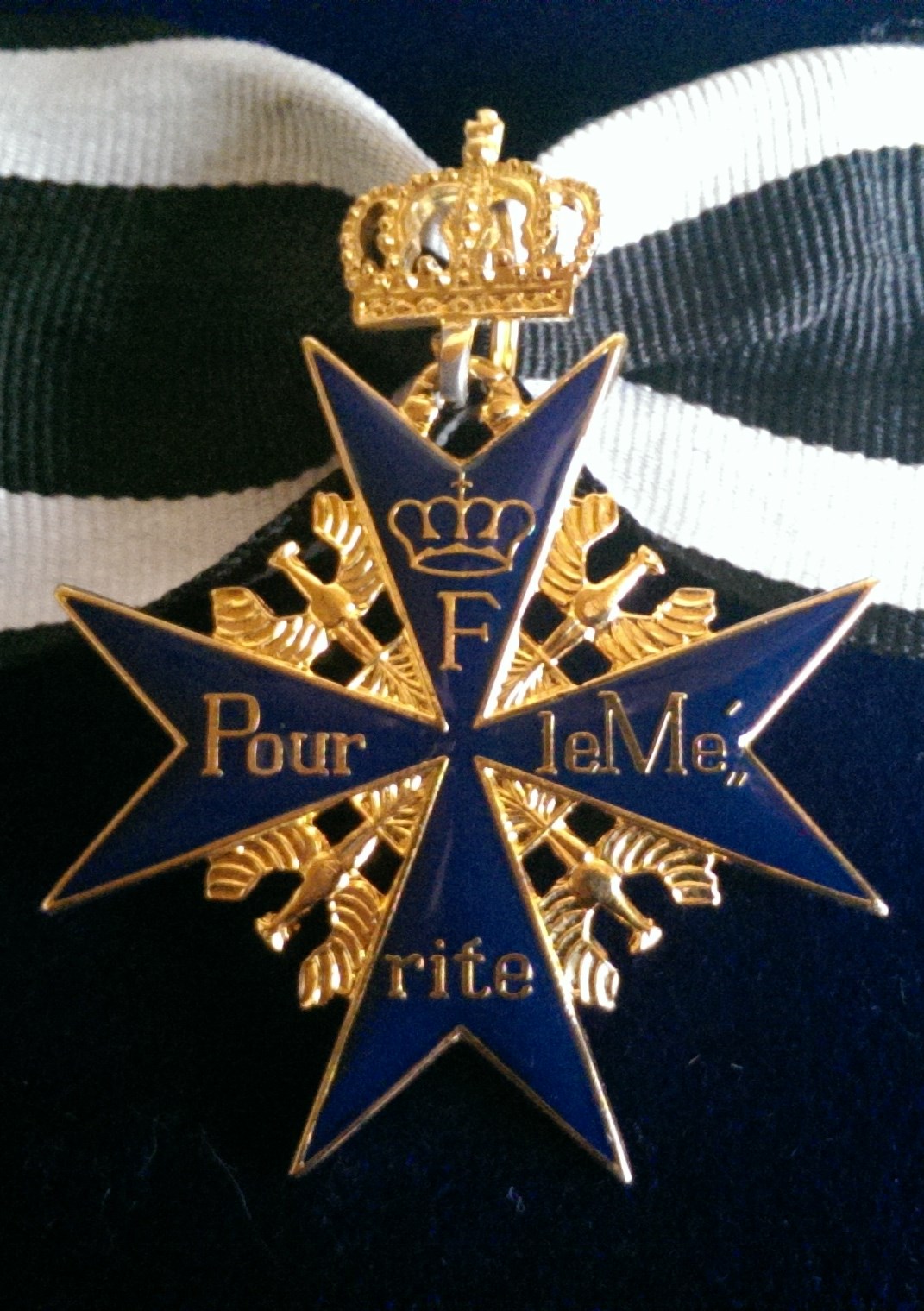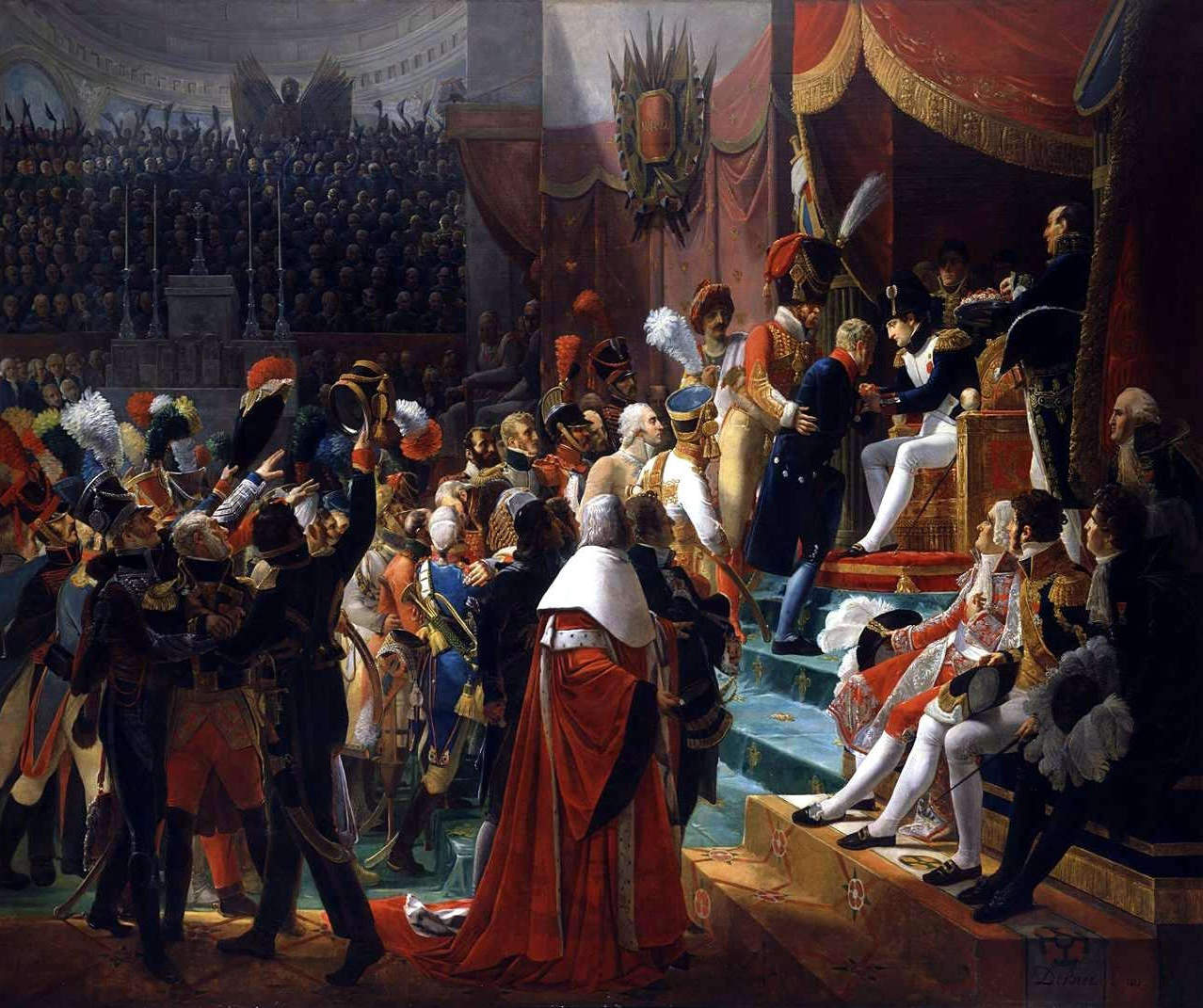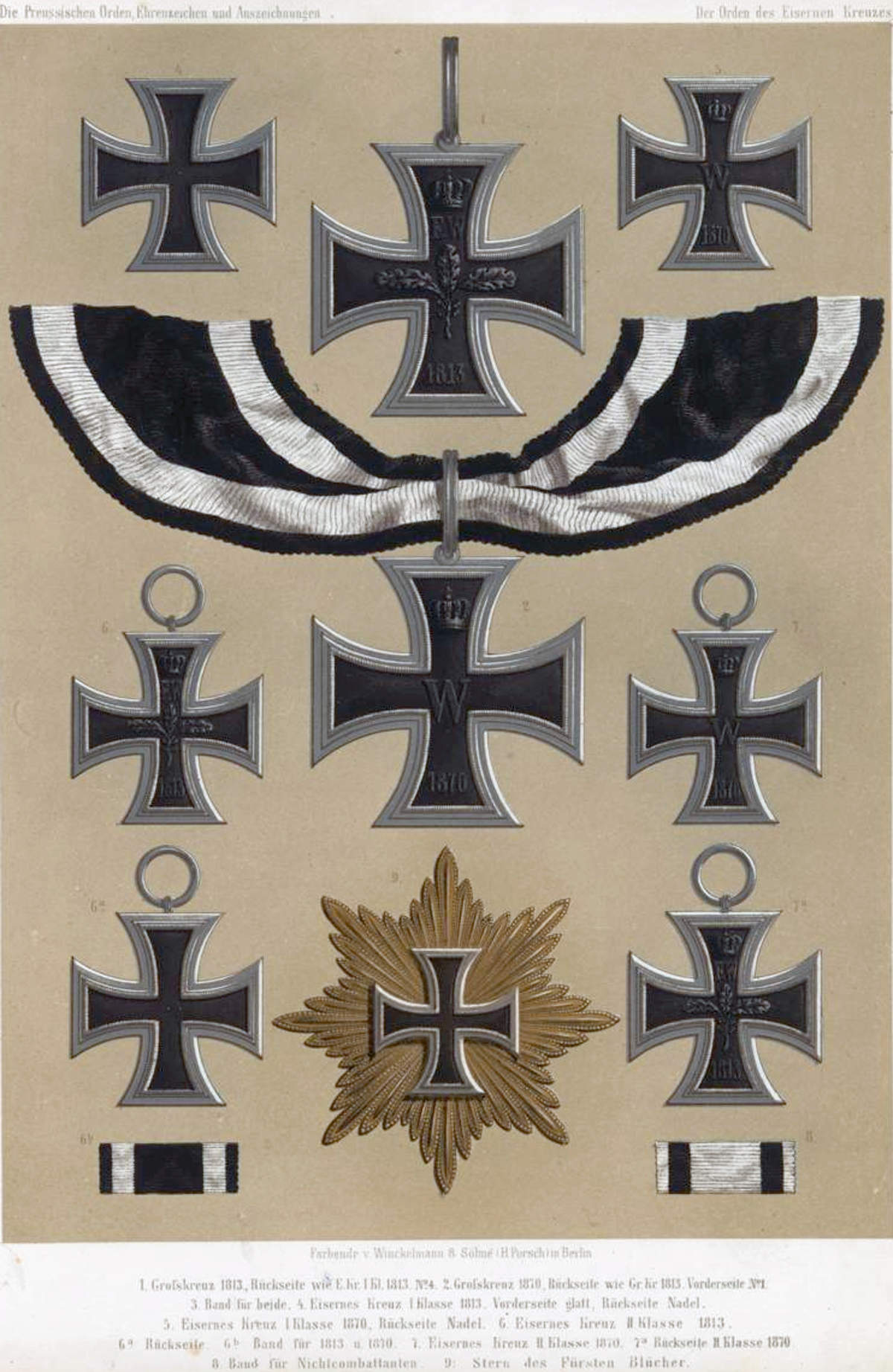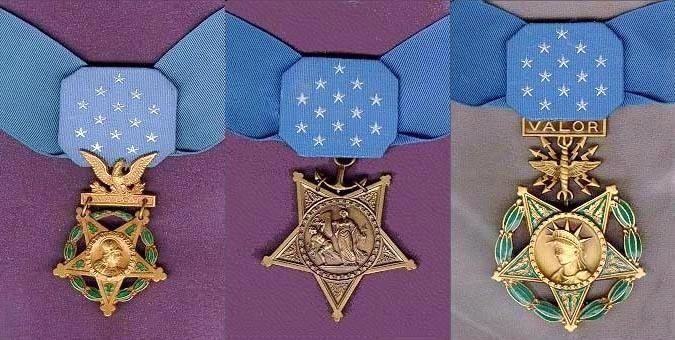- Version 1.0
- publiziert am 1. Februar 2023
Inhalt
1. Introduction
Orders and decorations are portable badges and insignia awarded to recognize or reward specific forms of service or meritorious conduct. These objects belong more broadly to the field of phaleristics, which among other things is devoted to the study of the formalized systems of reward in both historical and contemporary societies.1In addition to orders and decorations, phaleristics also extends to other forms of symbolic recognition such as coins, pins, sashes and ceremonial weaponry etc. See Henning, Eckart / Herfurth, Dietrich: Orden und Ehrenzeichen. Handbuch der Phaleristik. Cologne 2010: Böhlau. Likewise, although they take different forms and can be awarded in a variety of ways by both state and non-state actors, orders and decorations have historically been studied predominantly within the contexts of military institutions and their traditions and cultures.
In more theoretical terms, they are cultural artefacts which, together with their recipients, have an important role as symbols which can aide in the creation and reinforcement of cultural ideals and values as well as other forms of social stratification. Because of these functions, orders and decorations have been, and continue to be, important symbols of the heroic or specific heroic ideals. Indeed, in some contexts they represent the nexus of such concepts and can become conflated at a definitional level. This can be seen most readily within military structures and cultures, where ‘decorated’ ⟶soldiers are often automatically regarded as ‘war heroes’.
2. Historical development
Historically, this relationship finds its roots in the development of phaleristic systems in the late 18th and early 19th centuries, specifically in Europe. Prior to this period, these systems had primarily served as symbols of membership in a specific social or religious group, such as a landed aristocracy or to orders of chivalric knights.2Kirchner, Heinz / Thiemann, Hermann-Wilhelm / Laitenberger, Birgit (Eds.): Deutsche Orden und Ehrenzeichen. 6th edition. Cologne 2005: Heymanns, 16. Over time, this role had changed towards orders and decorations becoming objects denoting recognition of service through the creation of so-called ‘house orders’, such as the Prussian Pour le Mérite (1740).
Such orders however, were still the province of societal elites, symbolizing their relationship to sovereigns and rulers.3Wernitz, Frank: The Iron Cross 1813 – 1870 – 1914. The History and Significance of a Medal. Transl. by Anne Kozeluh. 2 Volumes. Vienna 2013: Militaria, 60-63. This exclusivity however was challenged by the creation of new, more egalitarian, decorations such as the French Legion d’Honneur (1802) and the Prussian Iron Cross (1813) following the political and social upheavals of the late 18th century. The introduction of the Levée en masse initiated what one scholar has called a “meritocratization” within military phaleristic systems, which now recognized individual military heroism regardless of social rank.4Vogt, Ludgera: “Zeichen der Anerkennung als Medien sozialer Differenzierung und gesellschaftlicher Integration”. In: Soziale Welt 48.2 (1997), 187-205, here 190.
Over the following century, the process of industrialization and its accompanying technological and sociological changes across most of the western world resulted in a vast increase in greatly expanded such systems to reward new categories of merit or else add new gradations to existing orders.5Between 1800 and 1945, for example, over 3,500 decorations were created by states eventually comprising parts of modern Germany, with 450 being created under National Socialism. See Kirchner et al.: Deutsche Orden und Ehrenzeichen, 2005, 22-23; Lumsden, Robin: Medals and Decorations of Hitler’s Germany, Shrewsbury 2001: Airlife, 17. Notable examples include the British Victoria Cross (1856) and American Medal of Honour (1861), both awarded to any individual soldier or officer for acts of extreme bravery in battle to any and typifying the egalitarian war hero image. This transformation did not only affect the military sphere, however, but in other areas as well, rewarding an expanding variety of forms of civilian merit and heroism, such as that of policemen or firemen. This phaleristic revolution, if it may be so named, arguably found its ultimate expression in the dictatorships of the mid-20th century, who created vast and complex phaleristics. Regimes such as that in Germany under National Socialism or Russia under Soviet marxism, created thousands of orders and decorations which combined ostensible egalitarianism with their own ideological conceptions of heroism and service to the state.6E.g. Lumsden: Medals and Decorations, 2001; Satjukow, Silke / Gries, Rainer (Eds.): Sozialistische Helden. Eine Kulturgeschichte von Propagandafigurenin Osteuropa und der DDR. Berlin 2002: Ch.Links (different entries).
Since the Second World War, phaleristics have undergone yet another transformation as tangible symbols of the heroic. A relative decrease in major wars involving the western world has meant that military phaleristics, and therefore the cultural significance of orders and decorations, has been somewhat diminished, arguably in favour of other forms of recognition prevalent in the civilian world. Nevertheless, recently there have been signs of a movement to preserve, or even revive, some of this lost significance. In Germany in 2007-2008, for example, considerable debate erupted in surrounding the possibility of renewing the long disused Iron Cross, an order deemed to have been delegitimized by its connection to National Socialism, for use by the current Bundeswehr.7E.g. Löwenstein, Stephan: “Die Rückkehr des Eisernen Kreuzes?”. In: Frankfurther Allgemeine, 06.03.2008. Likewise, in the United States there have recently been multiple attempts to pass legislation which would enshrine certain ascribed heroic values to military decorations in order to stop the rampant practice of ‘stolen valour’, or the illegal wearing of military decorations.8Laugesen, Amanda: “Models, medals, and the use of military emblems in fashion”. In: Rall, Denise N. (Ed): Fashion & War in Popular Culture.Chicago 2014: Intellect Bristol., 107- 122, here 112.
3. Status of historiography
Despite the intricate historical connection between phaleristics and the conceptualization of heroism in modern history, particularly that of Europe, it is difficult to identify a specific historiography dedicated to understanding this relationship. Phaleristics itself comprises a vast body of literature, mostly military in nature, which is updated yearly with new biographies of prominent winners of famous decorations such as the Victoria Cross or, more controversially, those used or created under National Socialism.9E.g. De la Billiere, Peter: Supreme Courage – Heroic Stories from 150 Years of the Victoria Cross. London 2004: Little & Brown; Scherzer, Veit: Die Ritterkreuzträger. Die Inhaber des Ritterkreuzes des Eisernen Kreuzes 1939-1945. Jena 2005: Scherzers Militaire-Verlag Ranis; Mikaelian, Allen: Medal of Honor. ‘Profiles of America’s Military Heroes from the Civil War to the Present’. New York 2002: Hyperion, or Fuhrmann, Horst: Pour le mérite. Über die Sichtbarmachung von Verdiensten. Sigmaringen 1992: Thorbecke. Likewise there are many object-histories devoted specifically to individual orders and decorations specifically, or national or transnational phaleristic systems more broadly.10E.g. Nimmergut, Jörg: Orden Europas. Regenstauf 2007: Battenberg Gietl. As one historian has pointed out, though, while this research is valuable, it is sometimes prey to the kind of “superficial positivism” to which orders and decorations are inherently given. In other words, they, like their subjects, stand to reinforce certain normativized conceptions of heroism and are therefore lacking the distance to be able to analyze orders and decorations as “moral communicators.” Furthermore, this literature often places disproportionate focus on the elites of different phaleristic systems, namely those who have received the highest orders and decorations, therein creating something of a skewed picture of how orders and decorations have illustrated conceptions of heroism.11Winkle, Ralph: Der Dank des Vaterlandes. Eine Symbolgeschichte des Eisernen Kreuzes 1914 bis 1936 Essen 2007: Klartext, 18. These missing perspectives have instead come mainly from the field of sociology and historical anthropology. Several generations of scholars in these fields, such as William J. Goode (1978) and Ludgera Vogt (1997), have sought to uncover the theoretical underpinnings of phaleristic systems as a socio-cultural phenomenon.12Goode, William J.: The Celebration of Heroes. Prestige as a Social Control System. Berkeley 1978: University of California Press; Vogt: “Zeichen der Anerkennung”, 1997. See also Krüger, Herbert: Allgemeine Staatslehre. Stuttgart 1966: Kohlhammer, and Zingerle, Arnold: “Die ‘Systemehre’. Stellung und Funktion von ‘Ehre’ in der NS-Ideologie”. In Vogt, Ludgera / Zingerle, Arnold (Eds.): Ehre. Archaische Moment in der Moderne. Frankfurt a. M. 1994: Suhrkamp, 96-116. These studies often draw heavily on the theories of Max Weber, Pierre Bourdieu, and Georg Simmel about honour and recognition as both social and cultural constructs as well as tools of political control.
While these two fields of literature have traditionally been quite separate, in recent years there have been encouraging signs of research by German scholars including Heinz Kirchner (et.al) and, notably, Ralph Winkle, who have begun to bring them together to create more nuanced studies of historical phaleristics.13Kirchner et al.: Deutsche Orden und Ehrenzeichen, 2005; see also Henning et.al.: Handbuch der Phaleristik, 2010; Schulze-Wegener, Guntrum: Das Eiserne Kreuz in der deutschen Geschichte. Graz 2012: Ares; Wulff, Aiko: “‘Mit dieser Fahne in der Hand’. Materielle Kultur und Heldenverehrung 1871–1945”. In: Historical Social Research 34.4 (2009), 343-355. Winkle’s work Der Dank des Vaterlandes (2007), is worthy of particular praise in this regard, providing a ‘symbolic history’ (Symbolgeschichte) of the Iron Cross between 1914 to 1936. Specifically, Winkle utilizes the aforementioned sociological literature in order to trace how this decoration represents evolving conceptions of honour and heroism during and following the First World War.14Winkle: “Der Dank des Vaterlandes”, 2007.
4. Future research
In terms of future research possibilities, Winkle’s pioneering study of the Iron Cross certainly represents an important precedent. Even within his own topic of the Iron Cross, for example, there is great deal of history to which his methodology could be applied and for which there is certainly unused evidence housed within in the Bundesarchiv, most notably pertaining to the period following the Second World War. Aside from the Iron Cross, there are of course manifold other historical orders, decorations and systems documented by phaleristic historians which could benefit from similar research and a more theoretical approach, especially in non-European/North American or colonial contexts. Likewise, there is certainly a gap to be filled regarding the role of non-military decorations as communicators of heroic values and ideals, beginning in the late 19th century and continuing even until the present day.
5. Einzelnachweise
- 1In addition to orders and decorations, phaleristics also extends to other forms of symbolic recognition such as coins, pins, sashes and ceremonial weaponry etc. See Henning, Eckart / Herfurth, Dietrich: Orden und Ehrenzeichen. Handbuch der Phaleristik. Cologne 2010: Böhlau.
- 2Kirchner, Heinz / Thiemann, Hermann-Wilhelm / Laitenberger, Birgit (Eds.): Deutsche Orden und Ehrenzeichen. 6th edition. Cologne 2005: Heymanns, 16.
- 3Wernitz, Frank: The Iron Cross 1813 – 1870 – 1914. The History and Significance of a Medal. Transl. by Anne Kozeluh. 2 Volumes. Vienna 2013: Militaria, 60-63.
- 4Vogt, Ludgera: “Zeichen der Anerkennung als Medien sozialer Differenzierung und gesellschaftlicher Integration”. In: Soziale Welt 48.2 (1997), 187-205, here 190.
- 5Between 1800 and 1945, for example, over 3,500 decorations were created by states eventually comprising parts of modern Germany, with 450 being created under National Socialism. See Kirchner et al.: Deutsche Orden und Ehrenzeichen, 2005, 22-23; Lumsden, Robin: Medals and Decorations of Hitler’s Germany, Shrewsbury 2001: Airlife, 17.
- 6E.g. Lumsden: Medals and Decorations, 2001; Satjukow, Silke / Gries, Rainer (Eds.): Sozialistische Helden. Eine Kulturgeschichte von Propagandafigurenin Osteuropa und der DDR. Berlin 2002: Ch.Links (different entries).
- 7E.g. Löwenstein, Stephan: “Die Rückkehr des Eisernen Kreuzes?”. In: Frankfurther Allgemeine, 06.03.2008.
- 8Laugesen, Amanda: “Models, medals, and the use of military emblems in fashion”. In: Rall, Denise N. (Ed): Fashion & War in Popular Culture.Chicago 2014: Intellect Bristol., 107- 122, here 112.
- 9E.g. De la Billiere, Peter: Supreme Courage – Heroic Stories from 150 Years of the Victoria Cross. London 2004: Little & Brown; Scherzer, Veit: Die Ritterkreuzträger. Die Inhaber des Ritterkreuzes des Eisernen Kreuzes 1939-1945. Jena 2005: Scherzers Militaire-Verlag Ranis; Mikaelian, Allen: Medal of Honor. ‘Profiles of America’s Military Heroes from the Civil War to the Present’. New York 2002: Hyperion, or Fuhrmann, Horst: Pour le mérite. Über die Sichtbarmachung von Verdiensten. Sigmaringen 1992: Thorbecke.
- 10E.g. Nimmergut, Jörg: Orden Europas. Regenstauf 2007: Battenberg Gietl.
- 11Winkle, Ralph: Der Dank des Vaterlandes. Eine Symbolgeschichte des Eisernen Kreuzes 1914 bis 1936 Essen 2007: Klartext, 18.
- 12Goode, William J.: The Celebration of Heroes. Prestige as a Social Control System. Berkeley 1978: University of California Press; Vogt: “Zeichen der Anerkennung”, 1997. See also Krüger, Herbert: Allgemeine Staatslehre. Stuttgart 1966: Kohlhammer, and Zingerle, Arnold: “Die ‘Systemehre’. Stellung und Funktion von ‘Ehre’ in der NS-Ideologie”. In Vogt, Ludgera / Zingerle, Arnold (Eds.): Ehre. Archaische Moment in der Moderne. Frankfurt a. M. 1994: Suhrkamp, 96-116.
- 13Kirchner et al.: Deutsche Orden und Ehrenzeichen, 2005; see also Henning et.al.: Handbuch der Phaleristik, 2010; Schulze-Wegener, Guntrum: Das Eiserne Kreuz in der deutschen Geschichte. Graz 2012: Ares; Wulff, Aiko: “‘Mit dieser Fahne in der Hand’. Materielle Kultur und Heldenverehrung 1871–1945”. In: Historical Social Research 34.4 (2009), 343-355.
- 14Winkle: “Der Dank des Vaterlandes”, 2007.
6. List of images
- 1Preussischer Hausorden „Pour le Mérite“ mit KroneLizenz: Gemeinfrei
- 2Jean-Baptiste Debret: Erste Verteilung der Dekorationen der Ehrenlegion 1804, („Première distribution des décorations de la Légion d’honneur dans l’église des Invalides, le 14 juillet 1804“), 1812, Öl auf Leinwand, Musée national du château de VersaillesLizenz: Gemeinfrei
- 3Formen des Eisernen Kreuzes von 1813 bis 1870, 1872, Abbildung von Louis Schneider.Quelle: User:Andreas Janik / Wikimedia Commons; publiziert in Schneider, Louis: Das Buch vom Eisernen Kreuze. Berlin 1872: Duncker. Online verfügbar unter: Digitale Sammlungen der Universität DüsseldorfLizenz: Gemeinfrei
- 4Viktoria-Kreuz, Vorder- und Rückseite, Abbildung zeigt das Viktoria-Kreuz von Richard Ernest William TurnerLizenz: Public Domain
- 5Medals of Honour: Army Medal, Marine and Coast Guard Medal, Air Force Medal, von links nach rechts: Heeres-, Seestreitkraft-, Luftwaffen-Medaille.Lizenz: Public Domain




